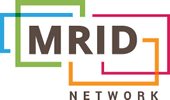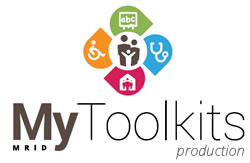What’s the MRID Network?
The Metro-Regional Intellectual Disability Network is a partnership model for improving health care for people with intellectual disability in regional and remote areas of New South Wales (NSW) run through the Kogarah Developmental Assessment Service. The MRID Network is one of three specialised projects commissioned by the New South Wales Ministry of Health to provide specialised services for people with intellectual disability. The MRID CodesignKit is one of a family of online toolkits – My MRID Toolkits – being produced as an initiative of the MRID Network. Visit the MRID SchoolKit to learn about how school clinics can be established to support children and young people with complex needs.
What is a multi-disciplinary team?
A multidisciplinary team consists of members from different backgrounds, each with their own specialised skills and expertise. In a healthcare setting in the disability sector, many different professionals may contribute to such a team. Some of these include:
Where has Co-Design come from?
Co-Design has been steadily introduced into more and more health service structures around the world over the last ten years, including in the United Kingdom, United States, Canada and New Zealand. In Australia, the National Safety and Quality Health Service Standards established in 2012 have defined partnering with consumers as a critical consideration in the design and delivery of all health services. Co-Design has become a central concept for the delivery of effective contemporary health care. Read more about the Co-Design concept at Why Co-Design?
How have the Co-Design tools and processes described in the CodesignKit been tested and evaluated?
The tools and processes described have been developed and refined across twenty years of collaboration between the Angelman Syndrome Association and the Angelman Syndrome Clinic. They have been further tested through the rollout of the Metro-Regional Intellectual Disability Network pilot into regional areas of New South Wales. The very nature of Co-Design processes means that evaluation and review structures are built into them so that they are continuously and repeatedly subject to testing and refinement. After twenty years the partnership between the Angelman Syndrome Association and the Angelman Syndrome Clinic is still going strong and Angelman-affected families are very satisfied with the quality of care and support services available to them. Whilst formal evaluation processes been used to demonstrate this over time- the ongoing success of our collaboration is perhaps is the greatest testament of all to the effectiveness and impact of Co-Design in action.
How does Co-Design work in practice?
Co-Design involves health professionals and consumers or carers talking to each other as equals and working together in partnership to create new strategies for improving health service delivery. This means sharing their knowledge and experience, listening to each other’s stories, making suggestions, exploring ideas and together determining the best ways forward. For more about the practice of co-design go to Co-Design from Scratch.
What do Co-Design tools do?
Co-Design tools structure and enable a conversation between health professionals, consumers and carers. They do several things at once – facilitate the sharing of information, create opportunities for mutual learning and development, provide a mechanism for identifying consumer priorities and allow for the exploration and development of new ideas and strategies.
How is Co-Design both macro and micro?
Co-Design involves a change of thinking and new ways of working. It places consumers, carers and families – their needs and their priorities – at the centre of everything. Consumers and carers are considered experts in the day-to-day management of the health condition that affects them. At a micro level this means consumers and carers are intimately involved in making all decisions – sometimes down to the smallest details – about the ways care and support services are provided to them personally. At a macro level it means that groups of consumers or carers are actively engaged as participants in driving the review and development of health services to ensure that the collective needs of the group are met.




